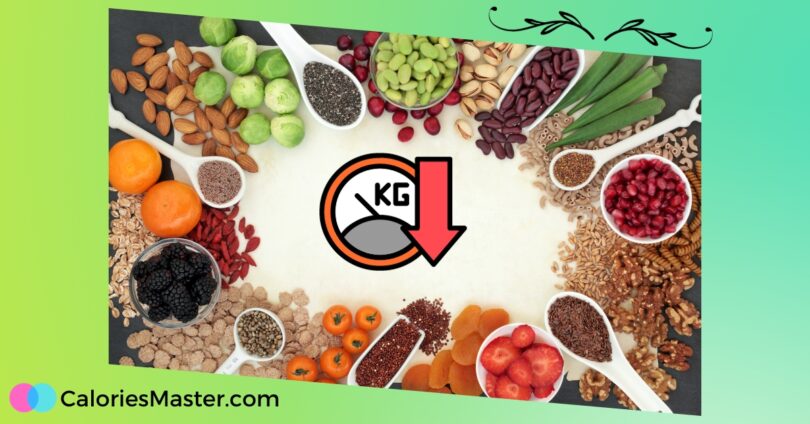Fibre is an essential nutrient that helps in maintaining a healthy digestive system. A high-fibre breakfast can be an excellent way to start your day, especially if you’re trying to lose weight. Fibre-rich foods keep you feeling fuller for longer, reducing the chances of overeating later in the day.
Studies have shown that a high-fibre breakfast can help with weight loss. A 2015 study found that participants who ate a high-fibre breakfast consumed fewer calories throughout the day and lost more weight than those who ate a low-fibre breakfast.
The study also found that the high-fibre breakfast group had lower levels of hunger and higher levels of fullness throughout the day.
In this article, we will explore the benefits of a high-fibre breakfast for weight loss and provide some ideas for delicious and nutritious breakfast options that are high in fibre.
Whether you’re looking to lose weight or simply want to start your day off on the right foot, a high-fibre breakfast is an excellent choice.
Understanding High Fiber Diet for Weight Loss
A high-fibre diet is a popular choice for those looking to lose weight.
This type of diet is based on the principle that foods high in fibre can help you feel fuller for longer, which can reduce your overall calorie intake. In addition, fibre can also help regulate blood sugar levels, which can reduce cravings and prevent overeating.
Fibre is a type of carbohydrate that the body cannot digest. It passes through the digestive system largely intact, helping to bulk up stools and prevent constipation.
There are two types of fibre: soluble and insoluble. Soluble fibre dissolves in water and forms a gel-like substance in the digestive tract. Insoluble fibre does not dissolve in water and helps to add bulk to stools.
Foods that are high in fibre include whole grains, fruits, vegetables, nuts, and seeds. It is recommended that adults consume at least 30 grams of fibre per day. However, many people do not consume enough fibre in their diets.
When increasing your fibre intake, it is important to do so gradually to avoid digestive discomfort. Drinking plenty of water can also help prevent constipation and other digestive issues.
In summary, a high-fibre diet can be an effective way to lose weight and improve overall health. By including more fibre-rich foods in your diet, you can feel fuller for longer, reduce cravings, and regulate blood sugar levels.
Benefits of High-Fibre Breakfast
A high-fibre breakfast has numerous benefits for weight loss and overall health. Here are some of the key benefits:
1. Promotes Satiety
Fibre is known to keep you feeling full for longer periods. This means that you are less likely to snack on unhealthy foods throughout the day, which can lead to weight gain. A high-fibre breakfast can help you feel satisfied and reduce your overall calorie intake.
2. Improves Digestion
Fibre is essential for maintaining a healthy digestive system. It helps to keep things moving smoothly and prevents constipation. A high-fibre breakfast can help regulate your bowel movements and improve your overall gut health.
3. Lowers Cholesterol Levels
Fibre has been shown to lower cholesterol levels, which can reduce your risk of heart disease. A high-fibre breakfast can help lower your LDL (bad) cholesterol levels and improve your overall heart health.
4. Controls Blood Sugar Levels
Fibre can help regulate blood sugar levels, which is important for people with diabetes. A high-fibre breakfast can help prevent spikes in blood sugar levels and improve insulin sensitivity.
5. Provides Essential Nutrients
Fibre-rich breakfast foods such as whole grains, fruits, and vegetables are also rich in essential vitamins and minerals. A high-fibre breakfast can help ensure that you are getting the nutrients you need to maintain good health.
In summary, a high-fibre breakfast can help promote weight loss, improve digestion, lower cholesterol levels, control blood sugar levels, and provide essential nutrients.
Types of Dietary Fibre
Dietary fibre is an essential component of a healthy diet that can aid in weight loss. There are two types of dietary fibre: soluble and insoluble fibre. Soluble fibre dissolves in water and forms a gel-like substance in the digestive system, while insoluble fibre does not dissolve in water and adds bulk to the stool.
Soluble Fibre
Soluble fibre can help lower cholesterol levels and regulate blood sugar levels. It is found in foods such as oats, beans, peas, lentils, fruits, and vegetables. Soluble fibre can also help you feel fuller for longer periods, which can aid in weight loss.
Insoluble Fibre
Insoluble fibre adds bulk to the stool, which can help prevent constipation and promote regular bowel movements. It is found in foods such as whole grains, nuts, seeds, and vegetables. Insoluble fibre can also help you feel full, which can aid in weight loss.
It is important to consume both types of dietary fibre as part of a healthy diet. Eating a variety of fruits, vegetables, whole grains, nuts, and seeds can help you meet your daily fibre requirements and aid in weight loss.
Examples of High Fiber Breakfast Foods
Eating a high-fibre breakfast is a great way to start your day. Not only can it help you feel fuller for longer, but it can also aid in weight loss by reducing hunger pangs and preventing overeating later in the day. Here are some examples of high-fibre breakfast foods to try:
Whole Grains
Whole grains are an excellent source of fibre and can be easily incorporated into your breakfast. Some examples include:
- Oatmeal
- Whole grain toast
- Brown rice
- Quinoa
- Whole grain cereal
Fruits
Fruits are a delicious and nutritious way to add fibre to your breakfast. Some high-fibre fruits include:
- Apples
- Berries
- Oranges
- Pears
- Bananas
Vegetables
Vegetables are a great way to add fibre to your breakfast while also providing essential vitamins and minerals. Some high-fibre vegetables include:
- Spinach
- Broccoli
- Sweet potatoes
- Carrots
- Brussels sprouts
Seeds and Nuts
Seeds and nuts are great sources of fibre and healthy fats. Some examples include:
- Chia seeds
- Flaxseeds
- Almonds
- Walnuts
- Pistachios
Incorporating high-fibre foods into your breakfast can help you feel fuller for longer and support your weight loss goals. Try mixing and matching these foods to create a delicious and satisfying breakfast that will keep you energised throughout the day.
High Fibre Breakfast Recipes
If you’re looking to lose weight, a high-fibre breakfast can be a great way to start your day. Not only does fibre help keep you feeling full and satisfied, but it can also help regulate your digestion and keep your blood sugar levels stable. Here are some delicious high-fibre breakfast recipes to try:
Oatmeal Recipes
Oatmeal is a classic high-fibre breakfast option that can be customised in many ways. Here are some ideas:
- Banana Nut Oatmeal: Cook 1/2 cup of oats with 1/2 cup of water and 1/2 cup of almond milk. Add 1 sliced banana, 1 tablespoon of chopped nuts, and a sprinkle of cinnamon.
- Pumpkin Pie Oatmeal: Cook 1/2 cup of oats with 1/2 cup of water and 1/2 cup of unsweetened pumpkin puree. Add 1 tablespoon of maple syrup, 1/2 teaspoon of pumpkin pie spice, and a sprinkle of chopped pecans.
- Apple Cinnamon Oatmeal: Cook 1/2 cup of oats with 1/2 cup of water and 1/2 cup of unsweetened applesauce. Add 1/2 teaspoon of cinnamon and a sprinkle of chopped walnuts.
Smoothie Recipes
Smoothies are a great way to pack in lots of fibre and nutrients in a convenient drink. Here are some ideas:
- Green Smoothie: Blend 1 cup of spinach, 1/2 cup of frozen pineapple, 1/2 banana, 1/2 cup of almond milk, and 1 tablespoon of chia seeds.
- Berry Smoothie: Blend 1 cup of mixed berries, 1/2 cup of Greek yoghurt, 1/2 cup of unsweetened almond milk, and 1 tablespoon of ground flaxseed.
- Chocolate Peanut Butter Smoothie: Blend 1/2 banana, 1 tablespoon of cocoa powder, 1 tablespoon of peanut butter, 1/2 cup of Greek yoghurt, and 1/2 cup of unsweetened almond milk.
Whole Grain Recipes
Whole grains are another great source of fibre and can be used in many breakfast dishes. Here are some ideas:
- Avocado Toast: Toast 1 slice of whole grain bread and top with 1/4 mashed avocado, 1 sliced hard-boiled egg, and a sprinkle of salt and pepper.
- Quinoa Breakfast Bowl: Cook 1/2 cup of quinoa with 1 cup of water. Top with 1/2 cup of black beans, 1/2 avocado, 1/2 cup of salsa, and a sprinkle of cheese.
- Whole Grain Pancakes: Mix 1 cup of whole wheat flour, 1 tablespoon of honey, 1 teaspoon of baking powder, 1/2 teaspoon of cinnamon, and 1 cup of almond milk. Cook on a griddle and serve with fresh fruit and a drizzle of maple syrup.
Remember to always choose high-fibre, whole-food options for breakfast to help keep you feeling full and energised throughout the day.
Tips for Incorporating More Fibre into Breakfast
Fibre is an essential nutrient that offers numerous health benefits, including weight loss. A high-fibre breakfast can help you feel fuller for longer, reducing the likelihood of overeating later in the day. Here are some tips for incorporating more fibre into your breakfast:
- Choose high-fibre cereals: Look for cereals that contain whole grains and at least 5 grams of fibre per serving. Avoid cereals that are high in sugar and refined grains.
- Add fruit: Adding fresh or dried fruit to your cereal, oatmeal or yoghurt is an easy way to boost your fibre intake. Berries, bananas, apples, and raisins are all excellent choices.
- Use whole grain bread: Swap out your white toast for whole grain bread. Two slices of whole-grain bread can contain up to 6 grams of fibre.
- Add seeds: Chia seeds, flaxseeds, and pumpkin seeds are all high in fibre and can be added to smoothies, yoghurt, or oatmeal.
- Try avocado: Avocado is a great source of fibre and healthy fats. Spread some mashed avocado on your toast or add it to your eggs for an extra fibre boost.
- Use legumes: Legumes such as beans, lentils, and chickpeas are high in fibre and protein. Add them to your breakfast burrito or omelette for a filling and nutritious meal.
Incorporating more fibre into your breakfast is an easy and effective way to improve your health and aid weight loss. By making a few simple swaps and additions, you can increase your fibre intake and feel fuller for longer.
Potential Side Effects of High Fiber Diet
While a high-fibre diet is generally considered safe and healthy, some people may experience side effects. Here are some potential side effects of consuming too much fibre:
Digestive Issues
Consuming too much fibre can cause digestive issues such as bloating, gas, and constipation. This is because fibre absorbs water, which can lead to a larger, bulkier stool that is difficult to pass. To avoid these issues, it is important to gradually increase your fibre intake and drink plenty of water.
Nutrient Absorption
Fibre can interfere with the absorption of certain nutrients, such as calcium, iron, and zinc. This is because fibre can bind to these nutrients and prevent them from being absorbed by the body.
To ensure that you are getting enough of these nutrients, it is important to consume a variety of foods and consider taking supplements if necessary.
Medication Interactions
Fibre can also interact with certain medications, including some antibiotics and cholesterol-lowering drugs. This is because fibre can bind to these medications and prevent them from being absorbed by the body. If you are taking medication, it is important to talk to your doctor before starting a high-fibre diet.
In summary, while a high-fibre diet can have many health benefits, it is important to be aware of the potential side effects.
By gradually increasing your fibre intake, drinking plenty of water, and consuming a variety of foods, you can minimise these side effects and enjoy the many benefits of a high-fibre diet.
High Fibre Breakfast for Weight Loss – Final Thoughts
Incorporating high-fibre breakfast options into your daily routine can be a simple and effective way to aid weight loss. By choosing foods that are high in fibre, you can help keep yourself feeling full and satisfied throughout the morning, reducing the likelihood of overeating later in the day.
Remember, it’s important to choose a variety of foods to ensure you’re getting all the nutrients your body needs.
Some great options to consider include oats, whole-grain toast, fresh fruit, and nuts. You can also experiment with different recipes and combinations to keep your breakfasts interesting and enjoyable.
In addition to helping with weight loss, a high-fibre breakfast can also provide other health benefits, such as improved digestion and reduced risk of heart disease. So why not give it a try and see how it works for you?
As always, it’s important to consult with a healthcare professional before making any significant changes to your diet or exercise routine. With their guidance and support, you can develop a healthy and sustainable approach to weight loss that works for you.









